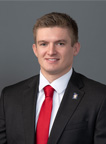H.J.R. 13 Joint Resolution Amending Court Rules of Procedure and Evidence Regarding Preliminary Hearings
| Bill Sponsor:  Rep. Clancy, Tyler | Floor Sponsor:  Sen. McKell, Michael K. |
- Substitute Sponsor: Rep. Clancy, Tyler
- Drafting Attorney: Jacqueline Carlton
- Fiscal Analyst: Heidi Jo Tak
- Bill Text
- Other Versions
- Related Documents
- Information
- Last Action: 12 Mar 2024, House/ to Lieutenant Governor
- Last Location: Lieutenant Governor's office for filing
Bill Status / Votes
• Senate Actions • House Actions • Fiscal Actions • Other Actions
| Date | Action | Location | Vote |
| 1/12/2024 | Bill Numbered but not Distributed | Legislative Research and General Counsel | |
| 1/12/2024 | Numbered Bill Publicly Distributed | Legislative Research and General Counsel | |
| 1/16/2024 | House/ received bill from Legislative Research | Clerk of the House | |
| 1/16/2024 | House/ 1st reading (Introduced) | House Rules Committee | |
| 1/17/2024 | House/ received fiscal note from Fiscal Analyst | House Rules Committee | |
| 2/7/2024 | House/ to standing committee | House Judiciary Committee | |
| 2/14/2024 | House Comm - Amendment Recommendation # 1 | House Judiciary Committee | 8 0 4 |
| 2/14/2024 | House Comm - Favorable Recommendation | House Judiciary Committee | 7 3 2 |
| 2/15/2024 (10:17:47 AM) | House/ comm rpt/ amended | House Judiciary Committee | |
| 2/15/2024 (10:17:48 AM) | House/ 2nd reading | House 3rd Reading Calendar for House bills | |
| 2/22/2024 (7:20:42 PM) | House/ 3rd reading | House 3rd Reading Calendar for House bills | |
| 2/22/2024 (7:21:35 PM) | House/ substituted from # 0 to # 1 | House 3rd Reading Calendar for House bills | Voice vote |
| 2/22/2024 (7:30:21 PM) | House/ passed 3rd reading | Senate Secretary | 68 0 7 |
| 2/22/2024 (7:30:23 PM) | House/ to Senate | Senate Secretary | |
| 2/23/2024 | Senate/ received from House | Waiting for Introduction in the Senate | |
| 2/23/2024 | Senate/ 1st reading (Introduced) | Senate Rules Committee | |
| 2/23/2024 | Senate/ to standing committee | Senate Judiciary, Law Enforcement, and Criminal Justice Committee | |
| 2/24/2024 | LFA/ fiscal note publicly available | Senate Judiciary, Law Enforcement, and Criminal Justice Committee | |
| 2/27/2024 | Senate Comm - Favorable Recommendation | Senate Judiciary, Law Enforcement, and Criminal Justice Committee | 3 0 3 |
| 2/27/2024 | Senate/ comm rpt/ sent to Rules | Senate Rules Committee | |
| 2/29/2024 | Senate/ Rules to 2nd Reading Calendar | Senate 2nd Reading Calendar | |
| 2/29/2024 (5:25:37 PM) | Senate/ committee report favorable | Senate Judiciary, Law Enforcement, and Criminal Justice Committee | |
| 2/29/2024 (5:25:38 PM) | Senate/ placed on 2nd Reading Calendar | Senate 2nd Reading Calendar | |
| 2/29/2024 (5:53:48 PM) | Senate/ 2nd & 3rd readings/ suspension | Senate 2nd Reading Calendar | |
| 2/29/2024 (5:57:58 PM) | Senate/ passed 2nd & 3rd readings/ suspension | Senate President | 28 0 1 |
| 2/29/2024 (5:57:59 PM) | Senate/ signed by President/ returned to House | House Speaker | |
| 2/29/2024 (5:58:00 PM) | Senate/ to House | House Speaker | |
| 2/29/2024 | House/ received from Senate | House Speaker | |
| 2/29/2024 | House/ signed by Speaker/ sent for enrolling | Legislative Research and General Counsel / Enrolling | |
| 2/29/2024 | Bill Received from House for Enrolling | Legislative Research and General Counsel / Enrolling | |
| 2/29/2024 | Draft of Enrolled Bill Prepared | Legislative Research and General Counsel / Enrolling | |
| 3/12/2024 | Enrolled Bill Returned to House or Senate | Clerk of the House | |
| 3/12/2024 | House/ enrolled bill to Printing | Clerk of the House | |
| 3/12/2024 | House/ received enrolled bill from Printing | Clerk of the House | |
| 3/12/2024 | House/ to Lieutenant Governor | Lieutenant Governor's office for filing |
Committee Hearings/Floor Debate
- Committee Hearings
- Floor Debates